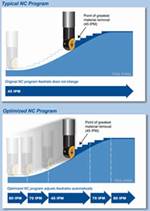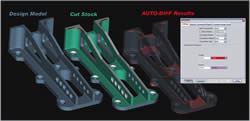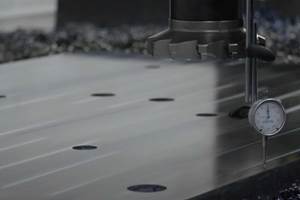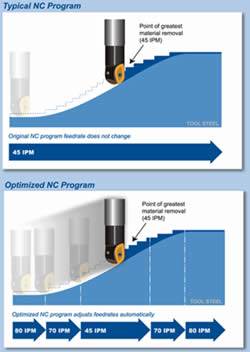Getting the Most from Your Multi-Axis Machines
The growing importance of simulation and verification of CNC machining processes.
Today’s manufacturing climate requires more precise NC Program verification techniques with faster results than ever before. But as these basic demands have increased, so has the complexity of the machines. The simulation and verification of CNC machining processes is becoming much more important with the increased use of high spindle speed CNC machines, five-axis machining centers and more complex fixtures and processes. Configuring these machines and producing error-free NC programs that are “right the first time” can be a monumental undertaking. Additionally, to stay competitive in the global marketplace, moldmakers are expected to create NC programs that run as efficiently as possible. Without fast, precise, verification and optimization tools, this can be an overwhelming task.
Most successful moldmakers utilizing CNC machinery seek out the latest in digi-tal manufacturing technology to improve their NC machining processes. And every moldmaker should be looking for tools that will give them a competitive edge.
NC Program Verification
NC programs often inherently contain errors. CAM systems and post-processors can both introduce errors. If the pro-grammer does not make any mistakes, there is a good chance this is because an extended amount of time was spent avoiding them. NC verification software is a crucial tool to avoid costly mistakes from getting to the shop floor. Oftentimes, prove-outs can be eliminated altogether.
When considering NC verification options, it is important to ask questions to ensure the software will be able to perform all the necessary tasks. A few questions the moldmaker may want to ask include:
- Does it verify the G-code program?
- Does it support advanced CNC control features used by the NC program, such as macro language, branching, probing and variables?
- Does it create an accurate in-process model?
- Can it verify cuts with different tool orientations, and can it remove material with a changing tool axis?
- Can it optimize the NC program feed-rates for varying cutting conditions, making the machines run more productively?
Advanced verification software accur-ately shows cut features, such as scallops created by a ball or bull-nose end mill. The software also provides analysis tools both during and after simulation to accurately measure the “as-cut” features. Taking the analysis a step further, the moldmaker can import the design model to compare it to the cut model. This detects and measures gouges and excess material at any point in the process (see Figure 1).
CNC Machine Simulation
In addition to simulating and verifying the NC program at the workpiece level, machine simulation software enables manufacturers to build and simulate their entire CNC machines in order to eliminate the potential for disaster in a machine crash. A machine crash can be very expensive, potentially ruin the machine, and delay the entire manufacturing schedule. But by simulating the machining process beforehand, the chance for error is dramatically reduced. Proving-out new programs on the machine becomes an unnecessary step—saving valuable production time.
Machine simulation software can detect collisions and near-misses between all machine tool components such as axis slides, heads, turrets, rotary tables, spindles, tool changers, fixtures, workpieces, cutting tools, and other user-defined objects. You can set up “near-miss zones” around the components to check for close calls, and even detect over-travel errors.
NC programmers should be wary of any simulation software that does not use continuous collision checking. Some simulation software only checks for collision at discrete locations along the path. If the moving components are not swept along the path it is possible that a collision occurring in between the discrete positions will not be detected.
The machine tool model can be created by the user or it can be supplied from the
software developer. Several sample ma-chines are supplied with the software and can be used as a starting point for the user to configure his specific machine. Most importantly, CNC controller models are supplied as well. These controls include various Fanuc, Siemens and Heidenhain models. Cycles, sub-routines, macros, loops, etc. for all popular CNC controllers are supported.
With some software it is now even possible to simulate multiple setups in a single session. Each setup has its own machine, control, fixtures, tools, NC programs and settings. The cut stock automatically moves from setup to setup. The machine models are separate from the stock, fixture and design component information. This information is simply “attached” to the machine when the NC programmer is ready to run a simulation.
NC Program Optimization
If a moldmaker wants to be competitive, it is crucial that every NC program use optimum feedrates for the most efficient machining possible. Not only are improper feedrates inefficient, they can damage the machine, cutter and/or the part. Optimized feedrates, on the other hand, increase productivity, prolong cutting tool life, reduce machine tool wear, and improve surface finish quality. The shop also will be much more likely to produce consistent results across machines, shifts, operators and programmers.
So how are feedrates optimized? Possibly a few feedrates could be optimized by hand. But besides being a very time-consuming and error-prone process it is extremely difficult to visualize the cutting condition for each cut, and the sheer volume of cuts in a mold machining program make it impractical. Some CAM software offers feedrate “optimization” based on motion direction. But without knowing the exact in-process material for each cut the results are not very effective. Some controls also offer “adaptive” feed control based on spindle load. But this is a very reactive—rather than proactive—process and spindle load is usually not a good predictor of cutting conditions. The only way to quickly optimize an NC program, for every cutting condition encountered, is to use software that is aware of the in-process state of material.
Without optimization software, the feedrate for a machining sequence is chosen by the NC programmer, typically based on a “best guess” of where the greatest amount of material will be removed or the “worst case” situation for the cutter and machine. Conversely, optimization software allows the NC programmer to specify the feedrate for ideal cutting conditions. The software then adjusts the feedrates depending on how close each actual cut is to the “ideal” situation. Feedrate optimization software that is aware of the in-process state of material can go even further, dividing each cut into smaller segments. The feedrate for each smaller segment is then adjusted according to its unique conditions. In addition to all of the other previously discussed benefits of optimization, this simple step often results in a machining time reduction of 30 to 50 percent or more. The key is that the software must know how much material is being removed at any given point in the toolpath.
Optimization for High-Speed Machining
High-speed machining also continues to be a hot topic. But, what is high-speed machining? Is it simply running at maximum feeds and taking shallow passes?
This technique is often much less efficient than taking fewer passes at greater depths. Maybe the true definition of high-speed machining is removing the most volume of material in the least amount of time. Achieving the shortest cutting time is related to feedrate, but the relationship isn’t “fastest feedrates = most efficient.” By varying feedrates the moldmaker can achieve the best results for all cuts.
In one recent high-speed machining test, two identical molds were cut. The only difference between the two was that one NC program was adjusted for “high efficiency machining.” The cutting depth was increased from 0.2 mm to 0.6 mm, the spindle speed was cut in half to accommodate the deeper cuts, and the feedrate was optimized using NC machining simulation software. The optimized part was cut in less than half the time and the reduction in cutter wear was significant.
Additional Uses of the In-process Model
The manufacturing process is improved when the NC programmer has the ability to easily create inspection instructions, CNC inspection programs and automated process documentation. With software that creates an accurate feature-rich model of the simulated workpiece, the inspection and process documents utilize and accurately reflect the in-process state of the workpiece at any stage of the process (see Figure 2).
In summary, NC program verification, optimization and machine simulation has evolved into an important process that protects and frees up CNC machines, helps to eliminates scraped parts, and creates in-process information that can be utilized throughout the moldmaker’s shop.
Related Content
How to Analyze and Optimize Cutting Conditions to Reduce Cycle Time
Plastic injection mold design and manufacturing company puts NC program optimization software module to the test. The results were surprising.
Read MorePredictive Manufacturing Moves Mold Builder into Advanced Medical Component Manufacturing
From a hot rod hobby, medical molds and shop performance to technology extremes, key relationships and a growth strategy, it’s obvious details matter at Eden Tool.
Read MoreHow to Produce More Accurate Molds and Reduce Rework
Patented micro-milling process for manufacturing steel plate flat and parallel helps mold builders shorten mold build times and increase accuracy.
Read MoreOEE Monitoring System Addresses Root Cause of Machine Downtime
Unique sensor and patent-pending algorithm of the Amper machine analytics system measures current draw to quickly and inexpensively inform manufacturers which machines are down and why.
Read MoreRead Next
Simulate and Optimize Your Mold Build Process
Mold shops can increase efficiency, lengthen tool and machine life and achieve better surface finish with the same software they use to verify their increasingly complex NC programs.
Read MoreHow to Use Continuing Education to Remain Competitive in Moldmaking
Continued training helps moldmakers make tooling decisions and properly use the latest cutting tool to efficiently machine high-quality molds.
Read MoreHow to Use Strategic Planning Tools, Data to Manage the Human Side of Business
Q&A with Marion Wells, MMT EAB member and founder of Human Asset Management.
Read More























